When writing this scenario I undertook to allow a broad range of actions and intentions by both sides. While a truly historical scenario might ignore anything on the Middle and Raymond roads and concentrate on events at Champion Hill itself, I wondered what would happened if generals on those axes were more active than they were historically.
That said, I used special cards and deployments to steer certain things historically, for instance putting in a special card for the Union which would temporarily prevent Loring's division from sending his brigades northward - "Does General Pemberton know the enemy is in great force in my front?"
I got great use out of Timothy Smith's Champion Hill: Decisive Battle for Vicksburg and James Arnold's Grant Wins the War: Decision at Vicksburg, I'd welcome any comments from readers, while suggesting that at times certain decisions of my were guided by gameplay rather than historical accuracy.
We did run the entire battle twice, both with significantly different results, I'm posting the second of those AARs here.
Morning
The Union generals began the day by developing their lines carefully and deliberating, under strict orders from Grant. Only in the centre did the attempt to move artillery batteries forward while sending a brigade after the 12th Arkansas Sharpshooter Battalion causes a less than orderly advance.
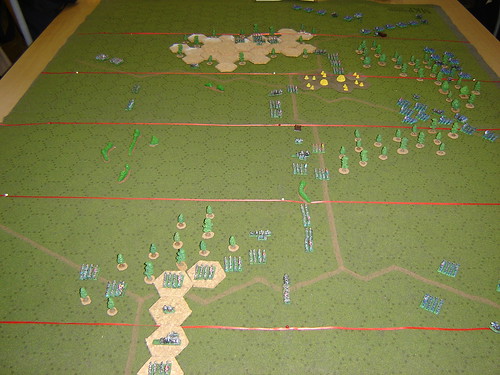
Aerial View of Battlefield at the start of the day
On the Union left, AJ Smith advances using the road to speed up his rear regiments while moving his forward units gradually off the road, being mindful of a Confederate brigade on his threatening his right flank.

AJ Smith leads division towards Croker Ridge
In the centre Bowen's division advances east of the Ratliff Road to catch the Union divisions before they can bring their superior numbers to bear.
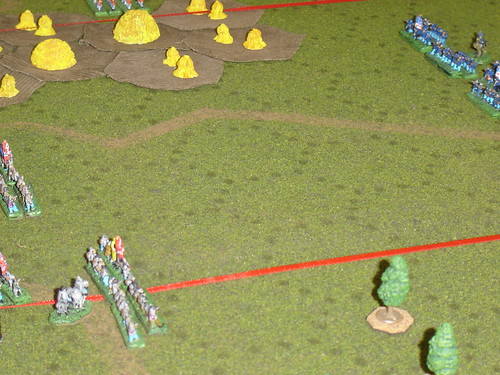
Osterhaus and Bowen square off on Middle Road south of Cornfields
As the Union divisions are just about to get their final orders to make contact with the Confederate defence, it is discovered that communications with Grant have slowed to a snail's pace, due to a huge number of supply wagons on the back roads connecting the main axes of advance.

Union rear on Raymond Road snarled up by supply train
Trouble strikes the Union centre as Carr's division struggles to clear the woods of a sharpshooter battalion impeding a quick deployment towards the line Osterhaus has identified for the two divisions.
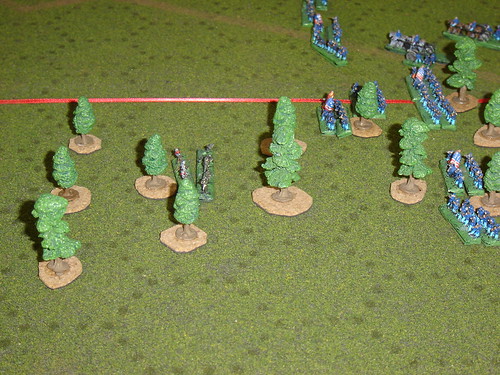
Carr's division finds advance through woods impeded by 12th Arkansas Sharpshooters
Further north, Logan's initial probe towards Champion Hill is repulsed. In the firefight, the 2nd Illinois and 6th Missouri Cavalry take advantage of the preoccupation of the Confederate gunners to overrun the Cherokee Georgia Battery. They escape with only minor losses despite the supporting fire from the slopes of Champion Hill from some of Cumming's Brigade and Claiborne's Battery.
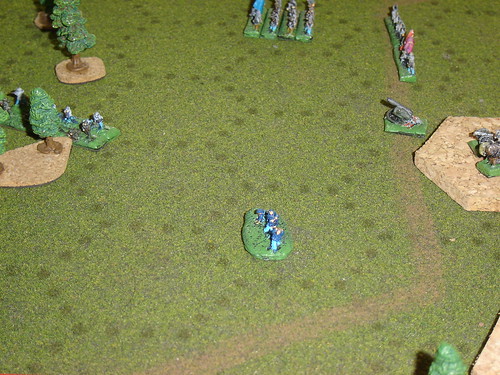
Logan's initial probe towards Champion Hill is repulsed
Afternoon
Just as AJ Smith’s division, supported by Blair begins its attack on Loring’s division on Croker Ridge, Buford’s brigade emerges from the woods nearby to hit them hard in the flank, forcing AJ Smith to respond by pulling back a brigade on that side.
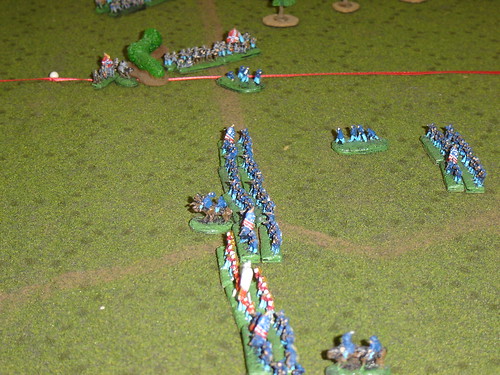
AJ Smith's division hit hard in the flank by Buford's brigade
Meanwhile in the centre things are getting hot, as Lee takes several regiments into the Cornfields for respite from Union pressure. He used his position to put some enfilading fire onto regiments marching down the Middle Road.

Lee leads regiment into Cornfield supported by Waddell's battery
Buford has successfully completed his task of slowing down the Union advance against Loring, and with only minor loss to his brigade. By afternoon Loring has brought all his regiments to the eastern edge of the woods and to the ridge itself, withdrawing Adam’s cavalry from its dangerous position covering the road.
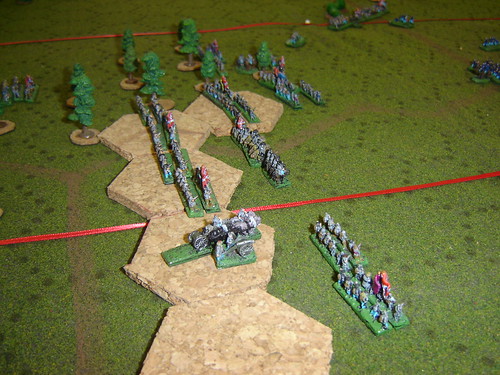
Loring's division prepares for Union onslaught
Meanwhile at Champion Hill Logan and Hovey are moving very conservatively on Confederate positions, keeping their lines steady and hoping to act like a vice in taking the position.

Logan's and Hovey's divisions advance on Champion Hill in good order
The Confederates there are not worried, having moved a brigade up to a defensive line, and skirmishing well with any Union regiment attempting to skirt the hill on the road.

Union troops can see Barton's brigade on north-eastern slopes of Champion Hill
With both sides almost spent and reduced to long-range exchanges in the centre (Bowern has been seriously wounded by a sharpshooter) and with things looking so dangerous at Champion Hill, Loring mounts a counter-attack after successfully weathering a full-scale assault by AJ Smith’s division, led by Buford’s brigade again.
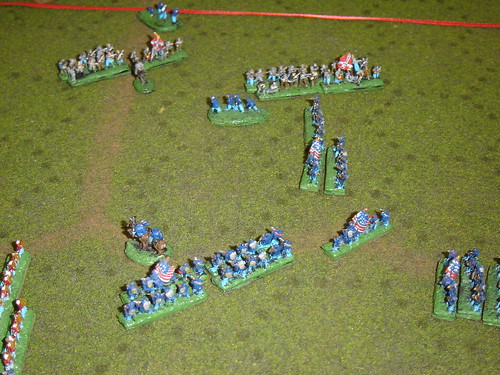
AJ Smith's division reels from counter-attack led by Buford
Evening
When Loring’s main strength joins in the counter-attack from the front, the effects are disastrous for the Union, and AJ Smith’s division, along with forward elements of Blair’s are driven from the field.
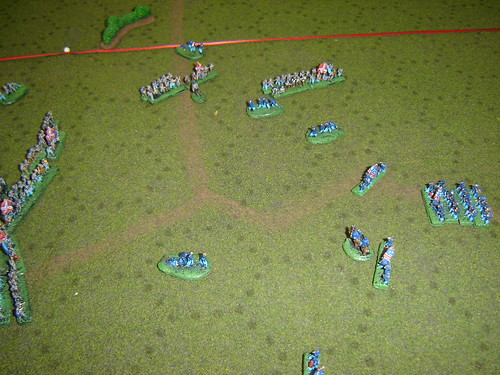
AJ Smith's division shattered by Loring's attack
The remains of Blair’s division supported by several batteries drive back the advance regiments of Loring’s division, giving them some room to reform their lines. However the absolute carnage caused to the Union divisions on this flank is clear to all, and Blair forms his new line out of Loring’s reach.

Blair's division forms new line outside range of Loring's guns
Loring begins to send his brigade north towards Champion Hill, but all wonder if the steady advance of Logan and Hovey will pay off before they can reach there, or before night falls. Their assault is coordinated and from both sides, leaving Cumming's and Barton's brigades shattered, and Stevenson himself has been seriously wounded taking command of a brigade on the eastern slopes near the road.
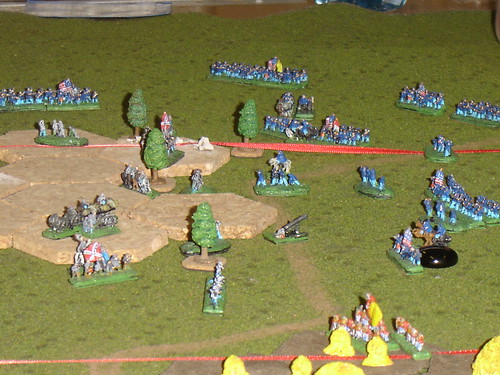
Logan and Hovey coordinate assault on Champion Hill
As the Union triumphantly surge up Champion Hill, only a lone battery commanded by Claiborne still stubbornly holds out.
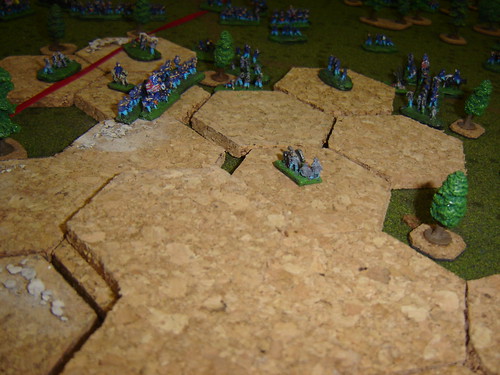
Lone guns of Claiborne's Battery hold to last man
The Confederates are broken, but the Union command looks nervous about their victory, and the Confederate commanders decide to break the Union strength by retaking Champion Hill before nightfall. They hope to effect a good withdrawal of the army and to hamper any future Union attempts to take Vicksburg. Before any fresh orders are sent, dusk falls and the day belongs to General Grant.
Aftermath
I’ll add a few comments as GM and observer. The Union approach was quite ponderous, requiring a full deployment before any real engagement. One could see the Union CinC player looking sternly at the subordinate players once or twice when they looked like they were getting ahead of themselves. This was most important around Champion Hill, where the Confederates had the best terrain, and the Union overwhelming numbers, and a division well in reserve which could have been completely left out of the picture by an overconfident player there. When that became apparent to all, I was slightly surprised that the Confederate on Champion Hill moved to a forward defence rather than a crest-line defence, which would have helped diminish Union superiority and coordination.
In the centre both sides were very quickly exhausted, with several units pulled out of the line when they were close to being destroyed. The sharpshooters did a lot of good work at frustrating the Union player here. Along the Raymond Road, all were amazed at the damage done to the Union, especially given the well ordered advance. Even so, they should probably have come out of it worse. When Blair’s units counter-attacked to set up their lines, 12 dice were rolled against various confederate units, with 11 (rather than the average of 6) coming up hits!
The Union won 18-20 (The Confederate break-point was 18 - the Union break-point was 23) so it was close enough in the end.
